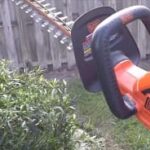As an Amazon Associate, this site earns commissions from qualifying purchases. For more information click here.
If your weed wacker or string trimmer does not produce spark, there is an issue with the ignition system. There are different types of string trimmers, but we can narrow the possible causes to just a few. This guide explains what the reasons are and the best ways to fix them.
Run a spark plug test and replace the plug if there is damage. Loose or frayed wires is another possible cause, or the ignition module might be defective. Once you have replaced the parts, run another test to see if the weed eater will run.
Important: wear PPE before you attempt to fix your weed eater. There is always a risk when dealing with sparks or anything that might cause smoke or fire. Take all necessary precautions especially when troubleshooting a gas powered weed wacker.
Defective Spark Plug
If a weed wacker has no spark, the first place to look is of course the spark plug. It is the component that sets off the combustion and starts the engine. Without any spark, the engine cannot run.
Solution. Turn off the ignition switch and disconnect the rubber boot from the spark plug. Use a socket wrench to unscrew the spark plug.
If the plug is warped, burned or damaged, replace immediately. If the spark plug looks fine, you can run a test to check if it is working.
How to Do a Spark Plug Test
This video shows you how to d a spark plug test on 2-stroke engines. If you prefer written instructions, there is one here too.
There are two ways to do this. The simpler method is to use a spark plug tester, which automates the process. The Infinite spark plug tester makes this easy to do.
The second method also works but takes more steps. Make sure you have thick working gloves and complete PPE.
- Put the spark plug back in place and reconnect the boot with the plug metal end pointed outwards.
- Put the weed wacker on a flat surface. Place your leg on the shaft to keep it steady, or ask someone to hold the weed eater down.
- Turn on the ignition and position the ignition wire under the spark plug boot.
- Look for a metallic surface on the engine block that touches the ground. Place tip of the spark plug on the metal surface about an inch away.
- Pull the starter cord. If the spark plug is working there will be a spark. If there is none, replace the spark plug and try again. However if there is still nothing, proceed to the other troubleshooting tips here.
Loose or Frayed Wires
Loose or frayed connections can cause a weed eater engine to stall. Loose wires are also dangerous as it can cause severe engine damage. Never run a weed wacker with loose wiring under any circumstances.
Solution. Check all the wiring on the trimmer. Now the configuration will vary, but the ignition wiring is critical.
Next, look into the spark plug boot. The wire has to be intact and must be debris-free. Remove all traces of dust and debris as this could affect the wiring. Remove the boot if necessary, but make certain the boot does not hang off the head trimmer wire. Tighten the wire if needed.
Finally, inspect the wires connecting the starter switch and ignition module. Ensure these are secure. Tighten loose wires.
Remove any cramping or pinching. None of the wires must make contact with any engine block component. Again, replace any damaged wires right away.
Damaged Ignition Module
The ignition system in most string trimmers contain the electric coil. It is the coil that generates the charge which goes into the spark plug and starts the engine.
The ignition system and spark plug work together to ignite the engine. If you replaced the spark plug, checked the wires and the engine still won’t spark, the ignition module is damaged.
Solution. Take the ignition module to a repair center or have it replaced. Never use a weed eater with a faulty ignition module. It can overheat the engine and the trimmer might smoke or catch fire.
If the ignition module is not working, replace it. There are replacements available for your make trimmer, as you just need to look up its make and model online.
Wrong Fuel Used
A 2-stroke weed wacker like the Craftsman WS2400 requires a mixture of gas and oil. Most use a 50:1 ratio, that is 50 parts gas to 1 part oil. Other 2-stroke engines use a 40:1 or 32:1 ratio.
A two-stroke engine gets lubricated from the oil mixed with the gas. So the wrong mix ratio will have a significant effect on the engine. If the mix ratio is really off, it might affect the ignition module.
Solution. Empty the fuel tank and pour a new mix. The fuel might suddenly gush out so make sure a container is in place.
If the fuel has been left in the tank for months, it might have turned into a sticky residue. You need to drain whatever fuel is left and then clean the tank. Soapy water and a brush can remove some of the grime. But for stubborn oil residue, use a fuel tank cleaner. There are products available for this.

Blocked Fuel Filter
There are two types used in string trimmers, air and fuel filters. While they are used to screen out debris, they can affect the way engine sparks work.
Fuel filters are used to keep fuel clean. It filters the fuel before it gets into the carburetor. If contaminants get in the mix, it could cause serious problems.
However, fuel filters eventually get clogged by these contaminants. If the filter is too dirty it won’t be able to keep debris out. The opposite happens as debris gets scattered throughout the engine.
The dirtier a fuel filter is, the less fuel gets in the engine. What fuel flows is littered with debris. Even if the engine starts it could stall. If the fuel is too dirty it could affect the ignition and prevent sparks.
The worst part about dirty fuel filters is the long term damage it causes. Dirty fuel wears out the engine and you will need to replace these parts much more quickly.
Solution. Open the fuel tank and empty the fuel. You will see the fuel line and the filter on it. Carefully take the filter out along with the fuel line.
Check the filter for signs of damage and if there is, replace it. You might be able to clean it, but in most cases it is better to get a new one.
Clean or Replace the Air Filter
Air filters keep the engine free from weeds, grass, plants, rocks, dust and other stuff that the trimmer sends up when it runs. As you trim the weeds, all kinds of material fly around you, which is why you need to wear PPE. The air filter serves a similar purpose for the trimmer.
The more you use the weed wacker, the more dirt accumulates in the air filter. Eventually the filter gets so clogged it can no longer function.
The excessive clogging (grass, weeds etc.) make things worse because the engine gets dirty. This can cause the engine to stop working. The other parts like the spark plug can get affected too. If the spark plug and/or ignition system is damaged, the fuel will not spark.
Solution. Clean the air filter regularly. It can be after every 30-50 hours of use, maybe more frequently. It depends on the environment and how much work your weed wacker gets.
If you trim weeds weekly, cleaning every 30-50 hours is fine. But you should also judge the situation yourself. If the trimmer is kicking up a lot of debris and the engine sounds unusual, check the air filter.
If you do not want to have to remember the numbers, go for regular cleaning. For example, clean every two weeks. That way you can prevent debris from building up.

I love the outdoors and all the tools for maintaining gardens, yards and lawns. The only thing I am more passionate about is sharing what I know about garden and outdoor equipment.


